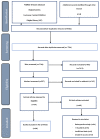Does Root Development Status Affect the Outcome of Tooth Autotransplantation? A Systematic Review and Meta-Analysis
- PMID: 35591712
- PMCID: PMC9103755
- DOI: 10.3390/ma15093379
Does Root Development Status Affect the Outcome of Tooth Autotransplantation? A Systematic Review and Meta-Analysis
Abstract
Background: Tooth autotransplantation is defined as the surgical repositioning of an autogenous tooth in another surgical site within the same individual. Aim: The aim of this research was to analyze the outcome of tooth transplantation using immature donor teeth compared with closed apex teeth and to compare differences between donor tooth positions on the arch. Methods: Electronic and manual literature searches were performed in different databases, including the National Library of Medicine (MEDLINE), EMBASE (OVID), Cochrane Central (CENTRAL), and the digital library of the Universitat Internacional de Catalunya (UIC University) from 1978 to March 2021. Studies were selected when they fulfilled the following criteria: only human prospective clinical studies, minimum sample size of 10 patients, minimum follow-up of 1 year, studies reporting or with at least deducible data on survival rates, immediate tooth autotransplantation with completed or incomplete root formation, and publications in the English language. A meta-analysis of random effects was developed to estimate the global effect measure of the survival rate, success rate, and root resorption involving the total sample, as well as open- and closed-apex groups. Results: Twenty-four articles were eligible for analysis. The Cohen's kappa corresponding to this review was 0.87, and the risk assessment was considered low-moderate for the included studies. Overall survival and success rates were 95.9% and 89.4%, respectively, with a mean follow-up of 4 years and an overall mean age of 25.2 ± 12.3 years. Closed apex teeth showed a survival rate of 3.9% lower than that of open apex teeth. Higher complication rates were found for both inflammatory external root resorption and replacement root resorption in the closed-apex group, without reaching statistical significance. Conclusions: Tooth autotransplantation is a viable treatment alternative, regardless of the apical condition, with high survival and success rates after a mean follow-up of 4 years. Open-apex donor teeth could be considered the gold-standard option, showing lower complication rates when compared to closed-apex donor teeth. Future randomized controlled clinical studies are needed to examine the long-term prognosis of this technique.
Keywords: closed apex; complete root formation; incomplete root formation; meta-analysis; open apex; systematic review; tooth autotransplantation.
Conflict of interest statement
The authors declare no conflict of interest.
Figures





Similar articles
-
A clinical follow-up study of 278 autotransplanted teeth.Br J Oral Maxillofac Surg. 1996 Apr;34(2):181-5. doi: 10.1016/s0266-4356(96)90374-5. Br J Oral Maxillofac Surg. 1996. PMID: 8861295
-
Prognostic factors, outcomes, and complications for dental autotransplantation: an umbrella review.Eur J Orthod. 2024 Jan 1;46(1):cjad067. doi: 10.1093/ejo/cjad067. Eur J Orthod. 2024. PMID: 37995718
-
[A retrospective clinical study on autotransplantation of teeth with complete root formation].Zhonghua Kou Qiang Yi Xue Za Zhi. 2018 Nov 9;53(11):736-740. doi: 10.3760/cma.j.issn.1002-0098.2018.11.004. Zhonghua Kou Qiang Yi Xue Za Zhi. 2018. PMID: 30419653 Chinese.
-
Long-Term Outcome of Autotransplantation of a Complete Root Formed a Mandibular Third Molar.Case Rep Dent. 2021 Nov 27;2021:5512804. doi: 10.1155/2021/5512804. eCollection 2021. Case Rep Dent. 2021. PMID: 34873454 Free PMC article.
-
Long-Term Evaluation of Tooth Transplantation: An Umbrella Review.J Clin Med. 2024 Jun 5;13(11):3341. doi: 10.3390/jcm13113341. J Clin Med. 2024. PMID: 38893052 Free PMC article. Review.
Cited by
-
How to Enhance Dental Implant Therapies and Definitive Restoration Outcomes to Reduce Complications and Improve Patient Well-Being.Materials (Basel). 2023 May 15;16(10):3730. doi: 10.3390/ma16103730. Materials (Basel). 2023. PMID: 37241357 Free PMC article.
-
Can different osteotomies have an influence on surgically assisted rapid maxillary expansion? A systematic review.Head Face Med. 2024 Mar 8;20(1):16. doi: 10.1186/s13005-024-00415-3. Head Face Med. 2024. PMID: 38459578 Free PMC article.
-
Autotransplantation of immature second premolar combined with alveolar ridge splitting: A long-term (6-year) follow-up case report.Aust Endod J. 2024 Dec;50(3):693-699. doi: 10.1111/aej.12886. Epub 2024 Nov 4. Aust Endod J. 2024. PMID: 39494977 Free PMC article.
-
Autotransplantation of Impacted Third Molars to DCIA Free Flap in Adolescent Patient: A Case Report.Children (Basel). 2025 Mar 16;12(3):370. doi: 10.3390/children12030370. Children (Basel). 2025. PMID: 40150652 Free PMC article.
-
Case of Pulp Regeneration Following Autologous Transplantation of an Incompletely Rooted Tooth.Case Rep Dent. 2025 Apr 8;2025:7121013. doi: 10.1155/crid/7121013. eCollection 2025. Case Rep Dent. 2025. PMID: 40291614 Free PMC article.
References
Publication types
LinkOut - more resources
Full Text Sources
Miscellaneous

